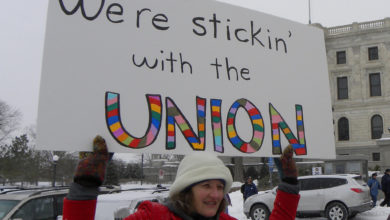The following is an excerpt from an article distributed by the ANSWER Coalition—Act Now to Stop War and End Racism—on June 2, 2006. Mara Verheyden-Hilliard is a civil rights attorney and co-founder of the Partnership for Civil Justice. Brian Becker is the National Coordinator of the ANSWER Coalition. The entire article can be found at www.answercoalition.org
 Three of the 15 Iraqi civilians killed in their Haditha home Photo: Reuters/Kareem Hareem |
Now that the butchery in Haditha is making headlines in the United States, high-ranking officials in the Pentagon as well as the President are promising an investigation. They have even announced “ethics training” for combat troops.
The implication is that something unusual happened when unarmed civilians, including terrified small children and their mothers who were trying to shield them, were riddled with bullets by U.S. soldiers. Were they rogue soldiers, lawlessly breaking ranks from an otherwise pristine mission aimed at liberating Iraqis?
That is pure fiction. Those who criticize the management of the war are talking complete nonsense when they say that the actions of these Marines will make it “harder to carry out the mission in Iraq.”
The Haditha massacre will not make the Iraqis think differently about the United States or Bush. It will only confirm their view, an outlook shaped by the cruel, cold-hard reality of the past years.
A pertinent revelation
In the Korean War, U.S. soldiers gunned down hundreds and possibly thousands of South Korean civilians as they tried to escape the horrors of war.
For five decades, the Pentagon and each successive U.S. administration denied these facts. South Korean survivors who tried to press their claims against the United States were labeled traitors and North Korean spies, and were put into prison for many years.
After the killings of No Gun Ri in July 1950 were exposed decades later in the U.S. media, the Pentagon even carried out an “exhaustive” investigation and concluded that the actions were those of inexperienced soldiers. “The deaths and injuries of civilians, wherever they occurred, were an unfortunate tragedy inherent to war and not a deliberate killing. … Soldiers were not ordered to attack and kill civilian refugees in the vicinity of No Gun Ri.” (Department of the Army Inspector General, No Gun Ri Review, Jan. 2001)
But just this week, as the Pentagon begins its new “investigation” into Haditha, a document has come to light that not only reveals the truth of the massacre of Koreans, but that it was an act of official U.S. war policy.
The day of the mass killings, the U.S. ambassador to South Korea sent a letter to State Department official Dean Rusk about the military decision arrived at during a meeting on July 25, 1950, announcing that Korean War refugees would be shot if they approached U.S. lines. The day after the decision, the 7th U.S. Cavalry Regiment killed hundreds of civilians at No Gun Ri in South Korea.
The logic of war crimes
There was a military rationale for killing the civilians at No Gun Ri and in scores of other sites throughout Korea during the war. The U.S. soldiers could not tell whether the civilians were sympathetic to the North Koreans or whether they would permit North Korean soldiers into their midst.
The Geneva Conventions expressly prohibit the targeting of civilians under any circumstances. But the Pentagon had a bigger political concern than adhering to international law.
The fundamental fear of the Pentagon and the White House in Korea, as it was in Vietnam and during the first and current war against Iraq, was that public opinion at home would turn against the imperialist adventure and tie the hands of the war makers. The logic of their political calculus was that U.S. public opinion would turn against the war directly as a result of a large number of U.S. casualties.
This thought took them to the next murderous conclusion: If civilians pose even a remote risk to U.S. soldiers, it is better to shoot the civilians first and ask questions later. Dead Korean or Vietnamese or Iraqi civilians will not be as politically damaging back home as dead U.S. soldiers.
There is one more side to the logic of war crimes. If the civilian population is sympathetic to the resistance fighters, it is necessary to terrorize the civilians as punishment for providing aid or shelter to a guerrilla army.
This is not a new story. The Japanese wiped out whole villages and nearly some cities in China as a warning against aiding the communist-led resistance during World War II. The Nazis’ policy in Serbia was to kill 100 Serbs for every German soldier killed by the resistance.
Under the direction of John Negroponte, current director of U.S. intelligence services, the Salvadoran military carried out large-scale massacres of peasant communities that were considered supportive of the FMLN resistance fighters in El Salvador during the 1980s. In Vietnam, the CIA organized the Phoenix Program, a clandestine war that assassinated as many 50,000 South Vietnamese who were considered to be members or sympathizers of the National Liberation Front.
The people of the United States must act
The war in Vietnam was not ended because “better politicians” were elected. No one could assert that Richard Nixon was better than anything or anyone.
What mattered was that millions of people used every avenue to intensify the mass struggle in the streets and in every community throughout the country.
The Vietnamese people were clearly determined to fight until their homeland was free from foreign occupation. Ultimately, the U.S. soldier was only fighting to return to his or her home.
The congruence of these factors and the ever-widening mass anti-war movement made the nearly genocidal conflict unsustainable for the Pentagon brass and the occupant of the White House.
We must learn and re-learn these lessons and apply them to today. That is the challenge and obligation of the next period.
Articles may be reprinted with credit to Socialism and Liberation magazine.






